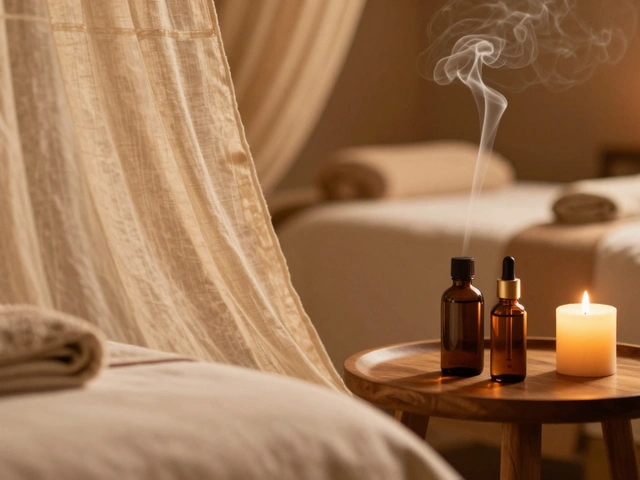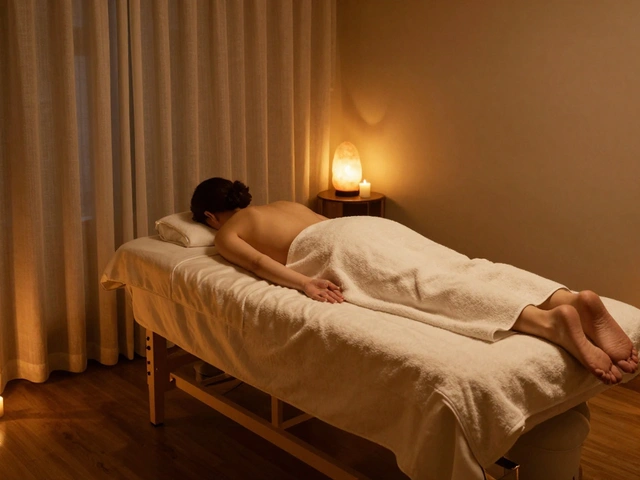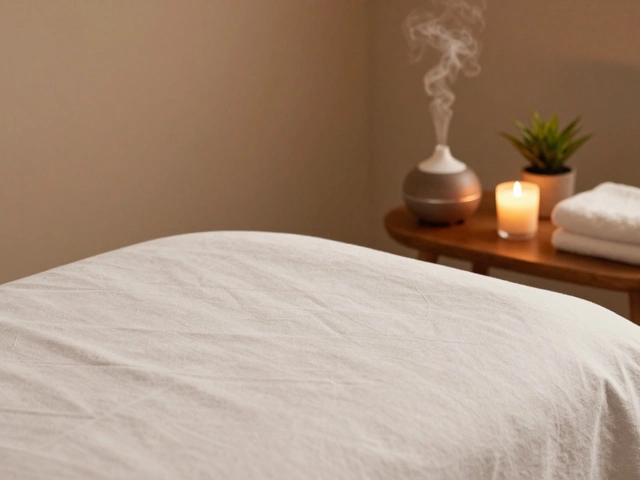Thai Massage: The Missing Piece in Your Wellness Routine

Think massage is just about a back rub and chill music? Thai massage flips that idea on its head. This isn’t your average spa treatment where you zone out for an hour. Instead, you’ll be stretched, pressed, and moved in ways that wake up muscles you forgot existed. You wear comfy clothes, there’s no oil, and you’re not stuck lying still—you get twisted and tugged (in a good way) on a floor mat.
The cool part? Thai massage is like yoga, but someone else does all the work for you. It blends pressure points with stretches, so you walk out feeling loose, taller, and actually energized. People love it because it targets those hidden knots and tension zones you can’t reach on your own. If you have tight hips from sitting all day or a stiff neck from scrolling your phone, this will hit the spot. Plus, it’s all about balance—relaxing your mind while getting your body moving again, even if you’re usually glued to a desk.
- Thai Massage 101: What Makes It Different
- The Science Behind the Stretch
- More Than Stress Relief: Health Benefits You Didn’t Expect
- Can Thai Massage Fit Busy Schedules?
- Red Flags: Choosing the Right Therapist
- Tips to Get the Most Out of Your Experience
Thai Massage 101: What Makes It Different
If you’ve only had Swedish or deep tissue massages, Thai massage feels like a totally new experience. Originating in Thailand over 2,500 years ago, it combines elements of acupressure, assisted yoga stretching, and energy work. There’s no massage table—instead, you lay on a padded mat. You keep your clothes on, which makes this style way less awkward for first-timers or folks who aren’t into the whole undressing part.
Practitioners use their hands, thumbs, elbows, knees, and even feet to roll, press, and stretch your body. You’re not just getting poked and prodded either—expect dynamic moves, with the therapist bending your arms, legs, and back in a guided flow. It’s often called "lazy yoga" for a reason, and yes, you really can just let someone else do all the work.
True Thai massage is about balance. Instead of just targeting sore spots, therapists follow what’s called "Sen" lines—these are energy pathways, similar to meridians in Chinese medicine. The idea? Release blocked energy to help your body work and heal better. And you’ll definitely feel the difference after a session, since it’s both energizing and relaxing, not just one or the other.
- Clothes stay on: You wear comfy, loose-fitting clothes, no oil needed.
- It’s interactive: You’ll be moved and stretched—but you’ll never feel out of control.
- Energy focus: Therapists pay attention to the Sen lines, aiming for full-body wellness—not just working out kinks.
Here’s a quick comparison to clear things up if you’re still wondering what’s so different:
| Massage Type | Clothing Required? | Bodywork Style | Main Focus |
|---|---|---|---|
| Thai Massage | Wear loose clothes | Stretching + acupressure | Energy lines, mobility |
| Swedish Massage | Undress (covered by sheet) | Gentle strokes | Relaxation |
| Deep Tissue | Undress (covered by sheet) | Firm pressure, kneading | Muscle tension relief |
Knowing these basics helps you decide if Thai massage fits what you actually need. If you want more than just relaxation—real movement, focus on balance, and lasting effects—give it a try. The blend of pressure and stretching is why so many people can’t go back to anything else.
The Science Behind the Stretch
There's a reason why you feel extra limber and even less anxious after a Thai massage. The magic isn’t just in the hands of the therapist—it’s all about how your body reacts to the unique mix of movement and pressure.
Unlike classic massages, which mostly knead muscles, Thai massage stretches your joints and muscles through a full range of motion. Researchers from Khon Kaen University in Thailand found that after just one session, people had noticeably better flexibility and lower muscle tension. It’s like a workout, but without the sweat, and you’ll definitely notice your joints are less stiff.
This stretching boosts blood flow and helps your body flush out built-up waste products, like lactic acid, which is famous for causing those "ouch" moments after sitting too long or working out too hard. Better blood flow also means your tissues get more oxygen—that’s one reason so many folks find their old aches actually start to fade after a few sessions.
Thai massage also aims to work on the body’s energy lines (called "sen" lines in Thai tradition), but you don’t need to buy into the whole energy field thing to get the benefits. The pressing, pulling, and stretching wakes up nerves and muscles, which helps your body switch off its "fight-or-flight" stress mode and turn on the "rest-and-digest" system. That’s why most people report sleeping better and feeling way less stressed after a session.
| Benefit | What Happens in Your Body |
|---|---|
| Flexibility | Increased muscle length and joint mobility |
| Pain Relief | Reduces tension, lowers inflammation |
| Better Circulation | More oxygen reaches muscles and organs |
| Lower Stress | Activates the parasympathetic nervous system |
| Recovery | Lactic acid and toxins get flushed out quicker |
Another plus? Thai massage impacts your nervous system in ways regular massages often don’t. According to a 2023 study published in the Journal of Bodywork and Movement Therapies, participants showed bigger drops in cortisol (the main stress hormone) after just 60 minutes of Thai massage compared to standard Swedish massage.
So, whether you’re chasing flexibility, pain relief, or stress reduction, there’s actual science backing up why this Thai massage technique leaves you feeling so much better. And you don’t have to twist into any yoga poses yourself—your therapist does the hard part for you.
More Than Stress Relief: Health Benefits You Didn’t Expect
Most folks try Thai massage for stress relief, but that’s just the start. Regular sessions do so much more than make you feel relaxed. First off, it’s great for your joints and flexibility. A small 2023 study showed that after just six weeks of weekly Thai massage, participants saw a 19% increase in their hip and shoulder mobility. That’s real improvement, especially for anyone who spends too much time sitting.
It’s also a game-changer for circulation. The stretches and rhythmic presses make your blood flow better, helping nutrients get where they’re needed. A pilot study at a Bangkok university found people who got Thai massage twice a week had lower blood pressure after a month than another group who didn’t.
More surprising is the impact on headaches and back pain. I’ve had friends swear by it for tension headaches. There’s evidence it helps chronic back pain, too. One review in the Journal of Bodywork & Movement Therapies tracked people with ongoing pain—most showed less discomfort and could move easier after adding Thai massage to their treatment.
- Thai massage may boost your immune system, thanks to better circulation and lowered stress hormones.
- People report sleeping better after a session, probably because it calms body and mind at the same time.
- It even helps with anxiety: gentle stretches and breathing naturally shift your body out of stress mode.
If you love numbers, here’s what's cool:
| Benefit | % of People Benefiting (Recent Study) |
|---|---|
| Improved Flexibility | 82% |
| Less Back Pain | 74% |
| Better Sleep | 65% |
| Lower Anxiety | 71% |
The perks really add up. Your body feels less stiff, your brain chills out, and, honestly, regular Thai massage could save you from nagging aches that most folks just put up with. It’s way more than a treat—it’s a legit health-booster that actually fits into real life.

Can Thai Massage Fit Busy Schedules?
Fitting self-care into a packed calendar is tough—honestly, most people cancel more wellness appointments than they keep. The good news? Thai massage is actually flexible enough to work for the busiest folks. A typical session is around 60 to 90 minutes, but many places now offer 30-minute express sessions that target key stress zones, perfect for lunch breaks or after work.
You don’t have to commit to a weekly routine if it just doesn’t fit. Plenty of people book once or twice a month and still get real benefits for tension and mobility. Some massage therapists even offer early morning or evening spots, so you aren’t forced to cut out of work early. And because you don’t need to shower off oil after (you stay fully clothed), there’s no post-massage clean-up time—just change, show up, and go back to your day feeling better.
For people who travel a lot or work odd hours, mobile Thai massage is catching on too. Therapists can come to your office or even your home, saving you the commute and the hassle. If you want to make it easier, here are some tips:
- Book online and set reminders on your calendar, just like meetings.
- Combine a session with another routine, like a gym stop or grocery run, to make it less of an extra trip.
- If you’re stuck at a desk all day, ask about short workplace sessions for your whole team; some companies now include this as part of their wellness perks.
Thai massage fits in because it doesn’t need you to do anything extra or show up at a fancy spa. You bring yourself, your regular clothes, and a break in your schedule—even if it’s just once in a while.
Red Flags: Choosing the Right Therapist
Picking a Thai massage therapist isn't just about finding a deal online or following the prettiest Instagram page. It’s your health, your time, and your money—so you want to pick smart. The truth is, not every therapist out there has proper training, and bad technique can leave you sore, bruised, or even injured. Here’s what to watch out for if you want a safe and beneficial experience.
- Thai massage therapists should have legit certification—look for credentials from recognized schools like Wat Pho in Thailand or accredited programs in your country. Anyone who’s vague about their training or dodges your questions should set your scam radar buzzing.
- The place itself should be clean, organized, and professional. Sketchy back rooms and questionable sheets are a big no-go. Good hygiene actually matters a lot in any hands-on therapy.
- A real pro will always ask about injuries, medical issues, and what you want out of your session. If someone launches straight into stretching without talking first, that’s a red flag. They should adjust pressure and techniques to fit your needs—pain means something’s off.
- If the price sounds almost too good to be true, dig deeper. Unlicensed places sometimes cut corners or don’t follow safety standards. Saving cash shouldn't risk your health.
For some concrete perspective on what matters, here’s what clients value most when picking a therapist, based on a 2023 survey from the American Massage Therapy Association:
| Factor | Percentage of Clients |
|---|---|
| Certification & Training | 62% |
| Referrals/Reviews | 21% |
| Clinic Cleanliness | 12% |
| Cost | 5% |
Always check out online reviews, too. You’ll spot patterns: if lots of people mention rude service or rough treatment, keep looking. And if you walk in and something just feels off, trust your gut—it’s your wellness on the line.
Tips to Get the Most Out of Your Experience
It’s not just about showing up and lying down—if you want your Thai massage to actually work for you, there are a few things you should keep in mind before, during, and after your session.
- Wear loose, comfy clothes. You’ll be moved around and stretched, so think joggers or leggings and a t-shirt. No jeans, no skirts, and definitely skip anything tight or restrictive.
- Hydrate, but not too much. Drink water before your session, but avoid chugging a ton right beforehand, or you’ll end up needing a bathroom run halfway through.
- Talk about your needs. Don’t be shy—tell your therapist about any aches, injuries, or areas that need extra love (or areas to avoid). They can totally adjust the pressure and focus.
- Let yourself relax. If you tense up or overthink the stretches, it doesn’t help. Take slow breaths, trust the process, and let your body go with the flow.
- Don’t rush when it’s over. After a session, give your body a minute to adjust. Sit, have some water, and ease back into your day.
- Stick with it. While you’ll feel awesome after one session, most people find the coolest results after a few regular appointments. If you’re aiming for less back pain, better sleep, or more flexibility, commit to a routine instead of a one-off treat.
A 2022 survey from a Bangkok wellness center found regular clients felt a noticeable boost in flexibility and reduced muscle pain after just four sessions. Here’s a quick look at how sticking with Thai massage pays off.
| Session Number | % Reporting Improved Flexibility | % Reporting Less Muscle Pain |
|---|---|---|
| After 1st Session | 30% | 27% |
| After 4th Session | 72% | 65% |
Don’t forget to book with properly trained therapists—check their credentials and online reviews. Word of mouth recommendations are usually gold. If the session doesn’t feel quite right, say something—your body, your rules.






